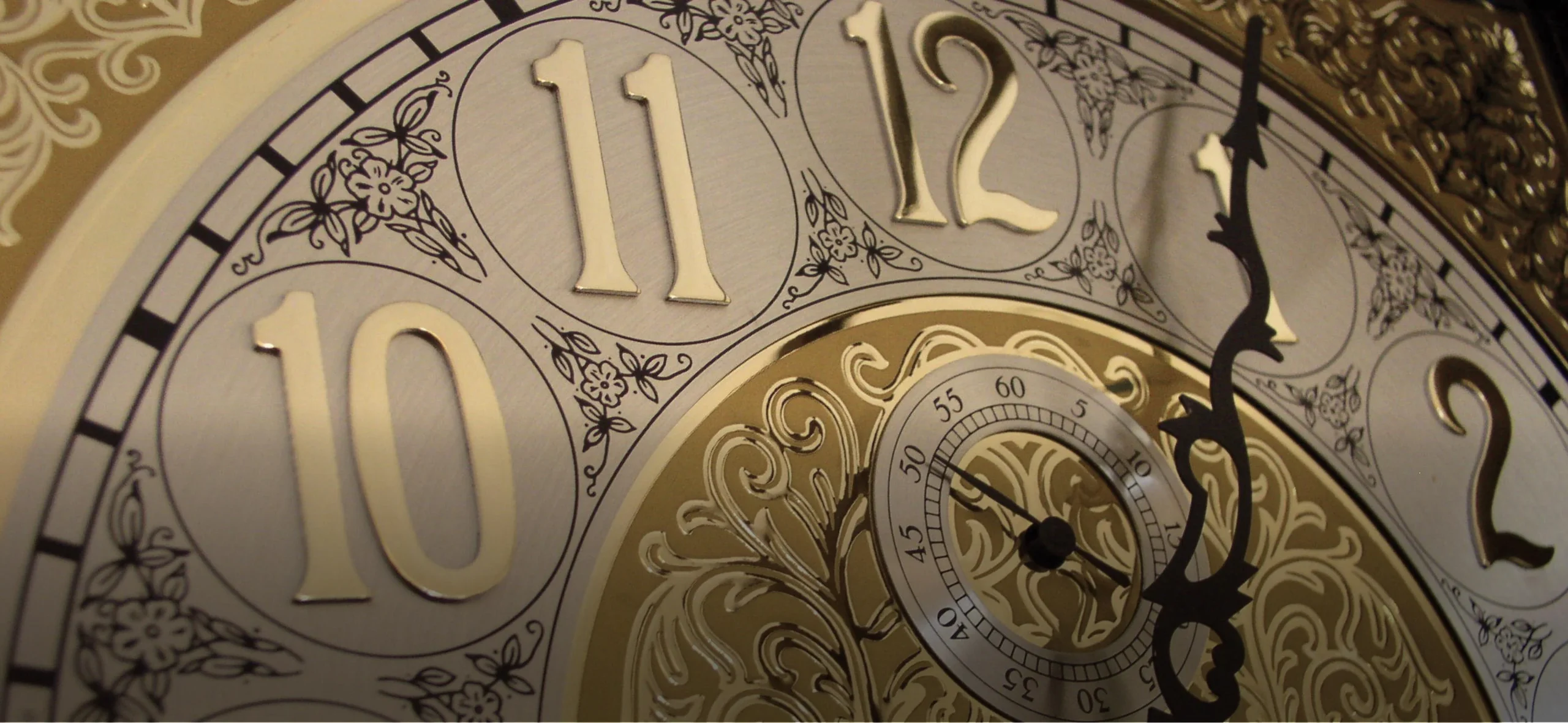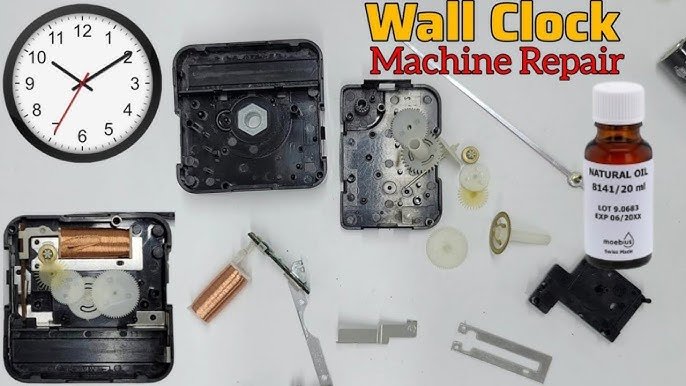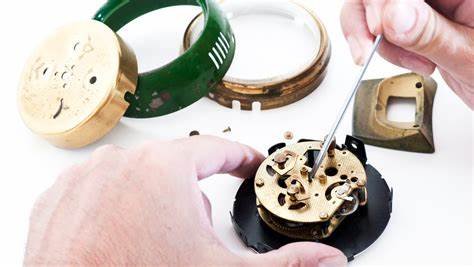When it comes to keeping your clocks in perfect working order, understanding the difference between repair and restoration is essential. While both terms are often used interchangeably, they refer to two distinct processes with unique goals. Whether you own a modern timepiece or a prized antique, knowing when to choose repair versus restoration can help maintain the longevity, beauty, and value of your clock.
What is Clock Repair?
Clock repair focuses on fixing specific functional issues to ensure that the clock works correctly. It is typically concerned with the mechanics of the clock, addressing problems such as:
- Broken or worn-out gears
- Malfunctioning pendulums
- Stopped or inaccurate timekeeping
- Winding mechanisms that don’t work properly
Repairs are generally limited to fixing the mechanical components, replacing faulty parts, and ensuring that the clock keeps accurate time. A repair job is usually quicker and less invasive than a full restoration, and it’s ideal for clocks that are relatively modern or don’t require aesthetic improvements.

Common Types of Clock Repairs:
- Replacing or adjusting clock hands
- Fixing pendulum movement
- Repairing mainsprings or gear trains
- Recalibrating the chiming mechanism
- Replacing broken glass or face components
When to Choose Repair:
If your clock is in good condition overall but no longer functions as it should, a repair is likely the best solution. It’s cost-effective and ensures the clock runs smoothly again without altering its appearance.
What is Clock Restoration?
Clock restoration, on the other hand, goes beyond just fixing the clock’s functionality. It involves bringing the clock back to its original or near-original condition. This can include extensive work on both the mechanical parts and the aesthetic elements such as the case, dial, and finish. Restoration is ideal for antique or vintage clocks where preserving historical value and appearance is crucial.
What Restoration Includes:
- Mechanical restoration: Rebuilding or replacing old or worn-out internal components with period-appropriate materials.
- Cosmetic restoration: Cleaning, repairing, or recreating the clock’s exterior, including the case, dial, and decorative elements.
- Refinishing: Polishing or reapplying finishes to wooden, metal, or enamel surfaces.
- Restoring lost parts: Fabricating or sourcing missing or damaged parts to match the original design.
Restoration requires a deep understanding of the clock’s history, materials, and construction techniques, ensuring that the clock’s historical integrity is preserved.
When to Choose Restoration:
If your clock is an antique or a valuable family heirloom, restoration is often the best option. Restoring both its mechanical functionality and aesthetic beauty can help preserve the clock’s value and ensure it lasts for generations to come.
Key Differences Between Repair and Restoration
| Aspect | Repair | Restoration |
|---|---|---|
| Focus | Functionality | Functionality + Appearance |
| Scope | Limited to mechanical fixes | Extensive, including aesthetic improvements |
| Timeframe | Short-term fix | Long-term, thorough process |
| Cost | Typically more affordable | Higher cost due to complexity and scope |
| Best for | Modern or functional clocks | Antique, vintage, or sentimental clocks |
| Goal | To restore function and accuracy | To restore both function and original appearance |
When to Opt for Repair
A repair job is ideal for clocks that still look great but no longer function properly. Modern clocks or those with minor mechanical issues typically benefit from repair. For instance, if your clock has stopped ticking, runs too fast or too slow, or its chime is off, a repair specialist can resolve these issues quickly.
If your clock has sentimental value but not much antique worth, a repair might be the more practical option. It will get your clock working without the need for a full overhaul.
When to Choose Restoration
Restoration is essential for antique clocks or those with significant historical, cultural, or financial value. If your clock’s exterior has suffered from age-related damage, such as fading, cracks, or missing parts, a restoration will bring it back to its original glory. This is especially important if you want to preserve the clock’s authenticity or pass it down as a family heirloom.
Restoration also includes mechanical repairs, but it focuses heavily on preserving or recreating the clock’s original look. It’s ideal for clocks that not only need to work properly but also require a return to their former aesthetic brilliance.
Conclusion: Making the Right Choice
Understanding the difference between clock repair and restoration can help you make the best decision for your timepiece. While repair is suitable for fixing immediate functional issues, restoration is a more extensive process aimed at preserving both the functionality and aesthetic value of the clock.
Whether you have a beloved family clock that needs a quick repair or a treasured antique in need of full restoration, knowing the distinction will ensure your clock continues to be a reliable and cherished part of your home for years to come.





Die Preise gelten für Aufenthalte von 3 Übernachtungen, die zwischen Dezember 2025 und Februar 2026 stattfinden.
Die Nutzung von Codes erfolgt in strikter Übereinstimmung mit
den allgemeinen Geschäftsbedingungen für Angebotscodes, einschließlich des geltenden Mindestbetrags.
Die Angebote gelten vorbehaltlich der Verfügbarkeit
für auf dieser Website gebuchten Urlaube. Im Innenbereich befindet sich ein ruhiges
Spa mit beheiztem Pool, Sauna und türkischem Bad sowie ein umfassendes Angebot an Massagen und Behandlungen, die dir beim Entspannen helfen. Er wurde vom berühmten brasilianischen Architekten Oscar Niemeyer entworfen und ist eine der renommiertesten Adressen der Insel – direkt neben dem Kreuzfahrthafen und nur
fünf Gehminuten vom Zentrum Funchals entfernt.
Das Dockside ist der ideale Ort für einen erholsamen Tag.
Hier finden an besonderen Terminen auch die Galadinner
statt, aber selbst an normalen Abenden erfordert die Kleiderordnung beim Abendessen ein wenig Sorgfalt, wodurch bei Ihrer Mahlzeit ein etwas
eleganteres Ambiente entsteht. Die Tagungs- und Konferenzräume im Pestana Casino Park, die den Gästen des Pestana Casino Studios zur Verfügung stehen, sind ideal für große Veranstaltungen, Konferenzen, Kongresse und Meetings.
Für ein Abendessen mit Live-Shows ist das Bahia
Restaurant im Casino die ideale Wahl.
References:
https://online-spielhallen.de/top-casino-freispiele-ohne-einzahlung-november-2025/
Probieren Sie es kostenlos aus, und finden Sie heraus, warum dieses Spiel vielen anderen Slot-Spielern so gut gefällt.Um
ein Spiel im Demo Modus zu starten, müssen Sie nur das Spiel laden und auf die “Start”-Taste.klicken. Spielen Sie den Slot kostenlos oder in den besten Echtgeld Casinos.
Bei den Innenwetten werden die Einsätze direkt auf die Zahlen platziert (zum Beispiele eine einzelne
Zahl, zwei benachbarte Zahlen, vier benachbarte Zahlen usw..).
Da es ziemlich kostspielig ist, diese Spiele zu betreiben, da diese einen Croupier benötigen, können die Live Dealer Roulette Spiele nur im Echtgeld-Modus gespielt werden. Nein, leider kann ein Live Dealer im Allgemeinen nicht kostenlos gespielt werden. Wählen Sie einfach ein betreffendes Spiel aus
unserer Auswahl derkostenlosen Roulette-Spiele aus, klicken Sie
auf das gewählte Spiel und schon werden Sie
Ihren ersten Einsatz tätigen können.
So gehen Sie auf Nummer sicher, auch wenn Sie sich später einmal entscheiden sollten, die angebotenen Spielautomaten um echtes Geld zu spielen.
Sie sollten sich aber stets davon überzeugen, dass Sie im einem bekannten Online Casino spielen. Da Sie beim Spielen von kostenlosen Slots im Internet kein Geld ausgeben müssen, gelten diese Spiele allgemein als die sicherere Alternative
zu den Echtgeld Slots.
References:
https://online-spielhallen.de/irwin-casino-auszahlung-dein-umfassender-leitfaden/
Players can enjoy a smooth experience on computers, tablets, and cell phones, among other
things. This means that every type of player can find something they like.
As soon as a player hits the basic level, they get points
for how well they play.
The service prioritises urgent queries from AU clients, connecting you
directly with friendly support managers who
understand local gaming requirements. Our progressive jackpots include network-linked games where prize pools grow across multiple
casinos. Our progressive jackpot slots offer life-changing prizes alongside
high RTP options for Australian players. Stay Casino delivers over 6,000 pokies
from premium developers like Pragmatic Play, NetEnt, and Microgaming.
References:
https://blackcoin.co/thrill-awaits-at-lucky-ones-casino/
All the casinos we recommend at Sun Vegas Casino are totally legit
and safe. New casinos will be proud of their security measures so you
should be able to find all this information in the footer of the website.
There are lots of new Australian casinos vying for your business.
The casino should provide several ways to connect like live chat,
email, or phone. This is especially important for bonuses and promotions, wagering requirements, and withdrawal limits.
Time2play.com is not a gambling operator and doesn’t offer gambling facilities.
One of the major benefits of using an established casino brand
like BetMGM or Bet365 is the security a global company
offers. Alternatively, checking trusted review sites or searching
for press releases about the casino’s launch can provide
further details. At Time2play, you’ll find only
licensed and regulated casinos, but I can’t vouch for anything
that you encounter out there on the big wild web.
Another issue is that established casinos can be less mobile-friendly as they weren’t designed for handheld devices, which can lead to a more cluttered mobile interface.
You can even extend this tracking to bonuses, which
can have varied wagering requirements, time limits, and game-specific
elements that can easily get confusing.
References:
https://blackcoin.co/woospin-premier-pokies-paradise-for-aussie-players-in-2025/
Jet4Bet Casino’s online pokies, powered by Betsoft, stood out for their stunning
visuals and bonus features like free spins and multipliers.
Always opt for properly licensed casinos only.Trusted casinos show clear licensing,
transparent bonus terms, SSL security, and public audit histories.
VR casinos and gamification (like loyalty quests) are next, with I realised there are a
few casinos already testing immersive features.
It’s clean, mobile-ready, and filled to the brim with
thousands of exciting games from trusted software providers… but its biggest advantage is how quickly it pays out, especially with crypto.
Not just in gameplay, but its cashouts, as well. Neospin serves up a 300% match bonus
good for up to A$11,000 in bonus cash with 300 free spins.
From deep-sea diving adventures like 40 Sharks by Tornadogames to jackpot giants like Grab
the Gold and Rich Piggies 2, there’s no shortage of themes, worlds,
and payouts to explore. It’s fast, it’s flexible, and
it’s loaded with features that feel built for everyday visitors.
Some sites, like Jackpot Jill Casino, process withdrawals in under 24 hours,
which is a big win for players who want their money fast.
I play pokies, table games, specialty games, and live dealer options to ensure they’re engaging and fair.
Make sure you’re playing on a licensed, safe online casino
with fast payouts, and secure banking. With its versatile A$11,000 welcome
bonus (plus 300 free spins) and stacked lineup of over 6,000 games, this platform just feels built for players who want a bit of everything in one
place. Here’s a quick recap of our top five Australian online casino sites to help
you decide.
Watch this how-to video for more on how to pay a cheque in using the app.
It’s never been easier to deposit cheques using your mobile device.
Are you having trouble logging into your
Business Internet Banking account?
In 2014, HSBC closed North London Central Mosque’s account and some
Muslim clients’ and groups’ accounts. The report also details HSBC’s dealings with known producers of cluster munitions and depleted uranium munitions.
The charity writes in its report that HSBC holds shares in the global arms industry totalling £450.6 million, and serves as principal banker for Meggitt, one of the UK’s largest arms companies.
References:
https://blackcoin.co/internet-casino-gambling-all-that-you-should-know/
casino online paypal
References:
https://ghibta.org/employer/best-paypal-online-casinos-accepting-us-players-2025
online blackjack paypal
References:
https://part-time.ie/companies/top-paypal-casinos-in-canada-2025-best-paypal-gambling-sites
online american casinos that accept paypal
References:
teachersconsultancy.com
paypal casinos for usa players
References:
https://arbeitswerk-premium.de/
online casino australia paypal
References:
careers.simplytech.co.za